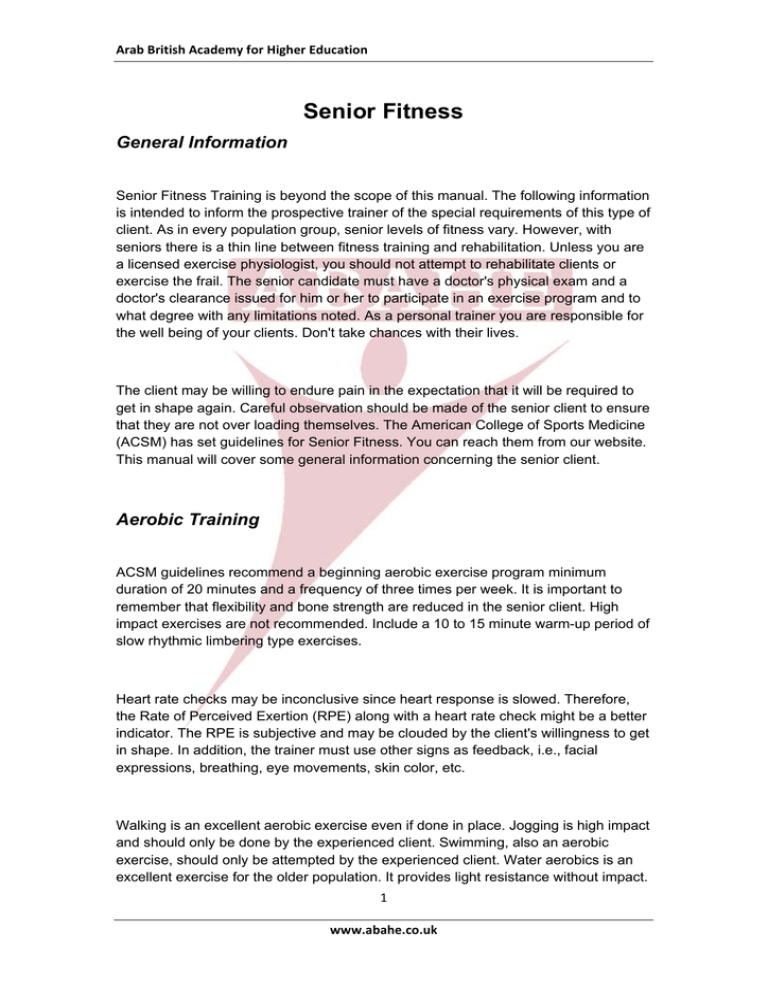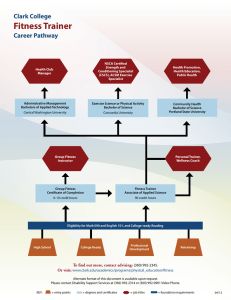
Arab British Academy for Higher Education Senior Fitness
General Information
Senior Fitness Training is beyond the scope of this manual. The following information
is intended to inform the prospective trainer of the special requirements of this type of
client. As in every population group, senior levels of fitness vary. However, with
seniors there is a thin line between fitness training and rehabilitation. Unless you are
a licensed exercise physiologist, you should not attempt to rehabilitate clients or
exercise the frail. The senior candidate must have a doctor's physical exam and a
doctor's clearance issued for him or her to participate in an exercise program and to
what degree with any limitations noted. As a personal trainer you are responsible for
the well being of your clients. Don't take chances with their lives.
The client may be willing to endure pain in the expectation that it will be required to
get in shape again. Careful observation should be made of the senior client to ensure
that they are not over loading themselves. The American College of Sports Medicine
(ACSM) has set guidelines for Senior Fitness. You can reach them from our website.
This manual will cover some general information concerning the senior client.
Aerobic Training
ACSM guidelines recommend a beginning aerobic exercise program minimum
duration of 20 minutes and a frequency of three times per week. It is important to
remember that flexibility and bone strength are reduced in the senior client. High
impact exercises are not recommended. Include a 10 to 15 minute warm-up period of
slow rhythmic limbering type exercises.
Heart rate checks may be inconclusive since heart response is slowed. Therefore,
the Rate of Perceived Exertion (RPE) along with a heart rate check might be a better
indicator. The RPE is subjective and may be clouded by the client's willingness to get
in shape. In addition, the trainer must use other signs as feedback, i.e., facial
expressions, breathing, eye movements, skin color, etc.
Walking is an excellent aerobic exercise even if done in place. Jogging is high impact
and should only be done by the experienced client. Swimming, also an aerobic
exercise, should only be attempted by the experienced client. Water aerobics is an
excellent exercise for the older population. It provides light resistance without impact.
1 www.abahe.co.uk Arab British Academy for Higher Education Stretching is important and should be kept to less than full range of motion followed
by static stretches. Be careful not to over stretch. Concentrate on slow, sustained
stretching.
Overhead arm stretches assist in breathing and allow the entry of more oxygen into
the lungs opening up the thoracic cavity. The atrophication of chest muscles can
cause breathing difficulty. These muscles are used to lift and expand the thoracic
cavity during inhalation.
Traditional dances done at weddings are a good idea. The dances are simple, well
known and not strenuous. They also provide a mood-lifting environment that
promotes good health.
Weight Training
Weight resistance is initially not recommended. It should only be used with the
experienced exerciser. Add light resistance rubber exercise bands and then light
weight hand weights. Keep in mind that getting up and down for the older population
may be difficult. Therefore, floor exercises may be difficult. Develop routines that use
a chair or the wall for support. Try single leg raises while seated. Upper body
exercises may be done while seated. Arm raises both front and side, leg extension,
Biceps flexion and upright row can all be done while seated to avoid stressing the
client. Avoid exercises that allow the head to be in extreme positions or move rapidly
so as not to invoke dizziness.
Nutrition
In addition to their doctor's recommendations:
Eat a small, easily digestible snack (such as crackers) prior to exercise.
Drink plenty of water before, during and after exercise to prevent dehydration.
Older populations lose their sensitivity to thirst and subsequently dehydrate
easier.
Wear loose, comfortable clothes to avoid movement restrictions. All Rights Reserved © Arab British Academy for Higher Education 2 www.abahe.co.uk




